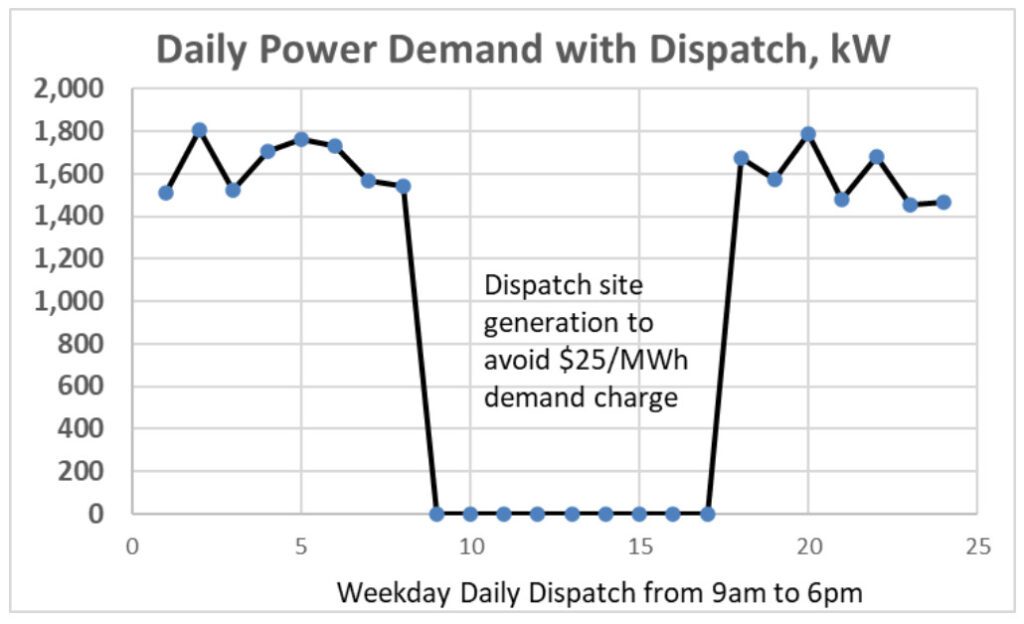Manufacturing and industrial facilities face serious challenges – rising energy costs, price volatility, power outages, and environmental concerns. In terms of cost (Table 1):
- State electricity riders for efficiency and renewable power add over $30/MWH to ComEd distribution costs.
- PJM ISO, the regional power transmission organization, capacity cost increased by a factor of 9 to over $100,0000/MW-yr starting June 1.
These high prices are likely here to stay due to the Illinois 2021 Climate and Equitable Jobs Act legislation which phases out large fossil fueled power in Illinois. Without large new power plant additions, Illinois’s power capacity issues will worsen.
Table 1: Illinois Electricity Cost
| Cost Category | 2025 Cost, $/MWh |
|---|---|
| Power & PJM ISO Ancillary Services | $56 |
| PJM ISO Capacity & Transmission | $20 |
| Utility Costs | $22 |
| Regulatory & Taxes | $33 |
| Current Total | $133 |
| 2024 Costs | $103 |
Facilities can take control of their power costs by recognizing that:
- 75% of the power cost is during peak periods and can be avoided using site generation
- C&I retail power costs are over 2x higher than PJM ISO real-time power costs
These two insights reveal that automated dispatchable site power generation can be leveraged to avoid peak power costs and provide a physical hedge for purchasing power from the real-time ISO power pool. This is accomplished by dispatching site power generation as shown in Table 2.
Table 2: Site Gen. Auto-Dispatch Savings
| Dispatch Generation | Savings $/MWh |
|---|---|
| When real-time prices are high as a hedge to enable purchase of real-time power for < $20/MWh | $42.2 |
| To avoid ISO capacity and transmission charges | $20.5 |
| To avoid ComEd demand charges, See Figure 1 | $22.4 |
| To avoid a portion of state regulatory charges (EE, renewable, etc.) | $13.5 |
| Cost of dispatching generation (fuel, operations, and maintenance) | ($30.7) |
| Net Customer Savings (49%) | $67.6 |

Figure 1: Avoiding ComEd Demand Charge
Dispatchable microgrids can also generate revenue by providing utilities and system operators with demand response to stabilize local utility distribution systems during grid upset conditions.
What is Dispatchable Site Power?
Dispatchable site power includes the following capabilities:
- Dispatchable Generation is a natural gas generator providing backup power and dispatch of site generation to reduce power costs.
- Fast start and 100% load step capability
- Ultra-low emissions
- Capable of up to 3,500 hours of dispatch annually to hedge real-time power procurement. Diesel power does not qualify.
- Modular Utility Paralleling Switchgear to integrate site generation without impacting existing electrical infrastructure while providing spare breakers for future zero carbon source integration. such as solar PV and battery energy storage (BESS).
- System Controller to enable remote operations while maximizing savings and performance.
- Fiber Communications Network
- Physical Hedge for purchasing lower cost power from the real-time ISO power pool
- Zero Carbon Options
- Purchase nuclear or renewable power that was sold into the ISO power pool at the hourly market price.
- Add solar PV generation and battery energy storage (BESS).

Figure 2: Power System Single Line
How to Get Started?
The first step is to perform a feasibility and optimization assessment working with your current supplier. Put simply, projects provide input and participate in a series of facilitated interviews to gather data and review procurement, site generation strategies, and financial returns. Typical feasibility and system optimization assessment steps include:
- Review high level feasibility issues including verifying sufficient space, air permit compliance, gas and electric interconnect availability, and noise limits.
- Review energy rates and procurement options to determine appropriate dispatch and procurement strategies.
- Build baseline hourly electric demand and cost model in a power modeling tool to ensure that the model is accurately estimating baseline year costs for the facility. This includes building rate models and downloading/manipulation utility provided electric interval data.
- Perform hourly electric demand and financial modeling to optimize the site generation equipment selection and sizing to maximize financial returns. This includes running multiple cases to compare rates, equipment options, and procurement options.
- For the optimized case estimate the costs, incentives, and return on investment.
- Generate report with recommendations, cost, financial performance, and financing options.
Summary
While significantly higher PJM ISO capacity charges take effect on June 1, 2025, Illinois facilities can take control of their power cost by integrating natural gas fired site generation into their electrical systems. The time has never been better with Caterpillar and other manufacturers releasing new lower cost natural gas packaged power systems and modular switch gear that:
- Reduce power system costs by 50%
- Provide for 100% load step capability to match the performance of a diesel engine
- Ultra-low emissions
- Lower cost utility paralleling switchgear with spare breakers for adding zero carbon technologies when economically feasible.
Installing and auto dispatching site generation enables facilities to purchase PJM ISO real-time power at less than $20/MWH while also avoiding peak power costs including ISO capacity and utility demand charges.
Facilities can reduce power costs by up to 50% while also building the site electrical infrastructure to enable plug and play of advanced site power generation technologies including solar and storage as these technologies improve.
For more information contact:
John Kelly at: john.kelly@wmeng.com
Mark Cosentino at: mark.cosentino@wmeng.com
